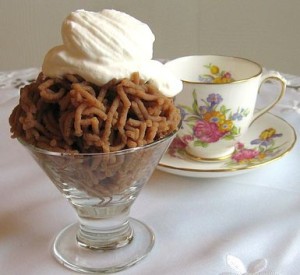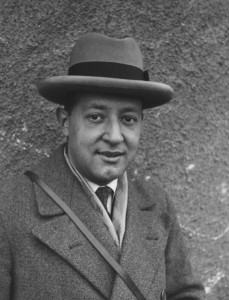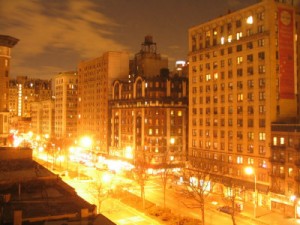HG is not a big fan of desserts. Usually prefers to end a meal with a cheese platter and red wine. However, HG recalls with fondness desserts HG enjoyed in New York of yesteryear. Number one, of course, was the hot fudge sundae at Rumpelmayer’s on Central Park South. This was also loved by young SJ and Lesley R. when HG took the youngsters to New York for a “treat day.”. Another great ice cream dessert was the vanilla ice cream ball rolled in toasted coconut. This was served at the Oak Room of the Algonquin Hotel. Other sweet splendors: Frozen banana daiquiris at Fornos; Nesselrode pie at Grand Central Oyster Bar; pots de creme at the Oak Room of the Plaza Hotel; cheesecake at Reuben’s (and Lindy’s); coconut custard pie at the Automat; strudel at Eclair. Ed Berberian’s Balkan-Armenian Restaurant on E. 26 Street served a wonderful middle eastern treat–Baklava with Ekmek. The Ekmek was a cross between ice cream and dense whipped cream. Perfect with the sweet pastry. HG is very fond of Paris bistro desserts: Tarte tatin with plentiful creme fraiche; creme caramel; ice cream (from Berthillon) and ile flottante (the best is at Le Stella). Favorite dessert in London is chestnut puree with whipped cream at Gay Hussar. When HG has a sweets craving on Prince Edward Island (which seems to be often, notes SJ), HG opts for Lebanese halvah or vanilla ice cream with Island maple syrup.
Dessert Gold from Around the World
August 16th, 2016 § 0 comments § permalink
Konrad Heiden
April 5th, 2016 § 0 comments § permalink
When HG was 23, HG began living, on and off, with Jeanette L., a wordily woman some 20 years his senior. It was a very instructive and rewarding relationship. Jeanette lived in Paris for a number of years and was friends with esteemed sculptors Ossip Zadkine and Chana Orloff. Jeanette gifted HG (almost 63 years ago) with an exquisite drawing by Zadkine’s wife, Valentin Prax. It hangs in HG’s New Mexico office and HG stares at it for a moment as HG types this post. Jeanette was close friends with many great German journalists, artists and musicians who emigrated to the United States after the rise of Hitler. Jeanette, a libertine, had intimate relations with many of them. One afternoon, on New York’s West 72nd Street, Jeanette and HG were lunching at Eclair, a delightful restaurant and pastry shop favored by European refugees. Jeanette introduced HG to a distinguished German journalist/historian, Konrad Heiden (1901-1966). Heiden encountered Hitler very early in the Nazi’s career. In 1923, when Heiden was one of Germany’s most prominent journalists, he described Hitler as “a demagogue at the head of an army of the uprooted and disinherited.” Heiden was frighteningly prescient. In 1937, he predicted The Holocaust. Hitler and the Nazis, he said had a “cooly calculated plan for the mass murder of Jews”. The “mass murder,” he wrote,”would be on a scale the world has not seen. We can only venture guesses on what the technical means these executions are to take.” In the late 20’s, Heiden went to a Berlin dinner party given by a society hostess. Hitler, a guest, was silent at the party, confining himself to eating many pastries and cookies. Then, the hostess made a light remark about Jews. Hitler arose and delivered a 30-minute tirade, his voice rising to a scream. He then left. Heiden remarked: “His voice was the most penetrating and powerful I have ever heard.” Heiden wore a number of books about Hitler and the Nazis. “Der Fuhrer”, published in 1944, was a best seller in the United States. Heiden said Hitler was a “great propagandist.” Heiden wrote: ‘The great propagandist hears the murmur of the masses. His actions are contradictory and misleading. However, the lies of the great propagandist reveal deeper truths about the world’s cynicism and dishonesty. By his lies the great propagandist involuntarily shows himself to be a self revealing prophet of the Devil.” Heiden’s words seem very relevant in terms of today’s political scene.
Young New Yorkers Living in Expensive Closets: Read This And Weep.
October 10th, 2012 § 0 comments § permalink
Some 48 years ago (seems like yesterday). HG, BSK, their two adorable children, their live-in mother’s helper and their poorly trained but decorative standard poodle, lived in a 12th floor Upper West Side apartment with dramatic views of the Hudson River and the New Jersey Palisades. A very spacious residence. Big living room. Big, separate dining room. Nice windowed kitchen and pantry. Four bedrooms and three baths (one en suite). The rent: $274 a month (later raised to $292 and a similar apartment in the same building now rents for $15,000 a month). Ah, rent control, you lovely bit of legislation (of course, obtaining this rent controlled paradise involved some bribery, chicanery and corruption). This did not shock HG, a born and bred New Yorker. In those days the Upper West Side was affordable and diverse. There was still a heavy Jewish influence. Big time theater and entertainment folks (Abe Burrows, Leonard Bernstein, Isaac Stern and many more) lived on Central Park West alongside many affluent professionals and business persons. Side streets from Central Park West to Broadway were gritty (except for W. 67th Street, site of the Des Artistes apartment house and many studios of painters and musicians). Riverside Drive and the Avenues and cross streets west of Broadway were filled with intellectuals and creative types who had more brains and talent than money. Forget Greenwich Village. The Upper West Side was the home of professors, critics, novelists, dancers, journalists, composers, actors, musicians and school teachers. Lots of European intellectuals who had fled Hitler and many Holocaust survivors (the little, pale, Nobel Prize winning writer, Isaac Baashevis Singer, who lived on W. 86th Street, often wrote about them). The Heresford (West Side apartment houses often had British names, a touch of Anglophile class) where HG and BSK lived, had much artistic ferment. Among its residents were Peter Boyle (before Hollywood and TV fame); film composer Michael Small, the critic and editor Ted Solotaroff; Gary Null, the health and sex writer, guru and radio personality. There were also some Broadway dancers, the cantor of a major synagogue and lesser artistic lights. The Upper West Side was filled with movie theaters showing art films (the New Yorker, Thalia and Symphony) and plus the first run houses (Loew’s 83rd, the Beacon,etc.). Food was a neighborhood obsession. Zabar’s, of course, but also Murray’s (preferred by some smoked fish aficionados) and Barney Greengrass (unsurpassed sturgeon). Middle European restaurants like Eclair and dairy restaurants like Steinberg’s and Paramount. Gitlitz’ Delicatessen on Broadway and 78th ( much superior in HG’s informed opinion, to Katz’s, Carnegie or 2nd Avenue Deli). The jewel of the West Side was the Tip Toe Inn (on Broadway near 86th Street). A huge place with a huge menu. Everything was delicious and inexpensive (the New York Public Library has a nice collection of old menus….Here’s a link to Tip Toe’s 1954 menu. Be astonished). There was a rotisserie in the Bretton Woods Hotel (86th and Broadway) that barbecued ducks and chickens. Sunday dinners for HG and BSK often featured one of those juicy, crisp skinned ducks and an avocado-sweet onion-sliced orange salad. Chinese restaurants were clustered around Broadway and 96th and they were very good (the first Szechuan restaurant in New York was on Broadway and 95th). There were also some Cuban/Chinese places where you could get good shrimp dishes plus Moros y Cristianos (black beans and rice) Fairway didn’t exist but for those who liked to eat at home there were butchers like Endicottt Meats and Nevada Market (where you could get some exotic stuff including bear, in season). Good bakeries. Mom and Pop greengrocers. Citarella’s for fish. Broadway Nut Shop for sweets. Daitch Dairy (79th and Broadway) for tub butter and cheese. Bretton Wood Rotisserie for barbecued ducks. HG and BSK were not plutocrats but could afford all of these good things. Yes, the Upper West Side had lots of junkies, hookers, muggers and burglars. Their presence made West Siders feel superior to residents of the antiseptic Upper East Side. Now, let HG make you young folks really jealous. HG, BSK and family spent all summer plus spring and fall weekends at their Fire Island home. Built atop a dune it had panoramic views of the Atlantic Ocean and Great South Bay sunsets. The family bought it for $40.000. HG’s first Fire Island house (in 1959) cost $4,000 ($1,000 for land and $3,000 for two bedrooms, bathroom, kitchen, living room and deck). In 1960, HG added two more bedrooms, another bathroom and additional decking. Cost: $2,000. That’s right. The numbers for these Fire Island properties are correct. Read and weep.
The Golden Age of Food On The Upper West Side.
December 21st, 2011 § 182 comments § permalink
It was 1963. HG and BSK were beginning their marriage in an artist’s studio apartment on West 67th Street just off Central Park West. Huge high ceilinged living room with north facing floor to ceiling window, small kitchen, small bedroom ( former model’s changing room), big bathroom with enormous tub. Very romantic. The rent: $140 per month.
This was The Golden Age Of Food On The Upper West Side. Gentrification and escalating real estate prices removed the gritty, funky luster. The neighborhood had junkies, muggers, burglars, hookers and bag ladies. It also had tons of artists, writers, academics and free ranging intellectuals lured by big apartments and cheap rents.
Here’s a smattering of the food and drinks establishments that delighted the newlyweds: 67th St. Wines (67th and Columbus): Splits of good champagne for a dollar. Volk’s German Restaurant (78th and Columbus): Bratwurst heaven. Fleur de Lis French Restaurant (65th off Broadway?): Escargots. Sole. Steak frites. C & L Restaurant (70th and Broadway?): Huge, Exceptional apple pancakes. Vast menu.  Tip Toe Inn (86th and Broadway). A sister restaurant to C & L with a great delicatessen. Also, notable chicken in the pot. Recently the Tip Toe Inn was featured on the show Mad Men and they were quite true to most of the original details. Zabar’s (81st and Broadway): Need HG say more? Now a New York landmark.
Tip Toe Inn (86th and Broadway). A sister restaurant to C & L with a great delicatessen. Also, notable chicken in the pot. Recently the Tip Toe Inn was featured on the show Mad Men and they were quite true to most of the original details. Zabar’s (81st and Broadway): Need HG say more? Now a New York landmark.
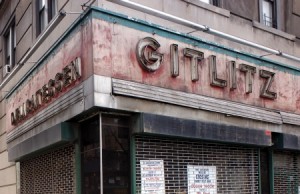 Nevada Market (80th and Broadway): Steaks. Chops. Chicken. Citarella’s (74th and Broadway): Everything fresh from the sea. Paramount Famous Jewish Dairy Restaurant (72nd west of Broadway): Blintzes. Gefilte fish. Kasha varneshkes. Steinberg’s (84th and Broadway): Same cuisine as Paramount but classier. Very good herring. Great Shanghai (98th and Broadway) Chinese lobster and shrimp dishes. Dumplings. Szechuan (95th and Broadway) Fire on a plate. New York’s first and best Szechuan restaurant. Broadway Nut Shop. (East side of Broadway and 81st): Encyclopedic array of fresh roasted nuts, dried fruits and candy treats from across the globe. Eclair Bakery and Restaurant (72nd Street): Vienna, Berlin, Budapest and Warsaw transplanted in New York. Senate Cafeteria (96th and Broadway): Where I.B. Singer ate his tunafish salad in the company of tea sipping, Yiddish speaking European survivors.
Nevada Market (80th and Broadway): Steaks. Chops. Chicken. Citarella’s (74th and Broadway): Everything fresh from the sea. Paramount Famous Jewish Dairy Restaurant (72nd west of Broadway): Blintzes. Gefilte fish. Kasha varneshkes. Steinberg’s (84th and Broadway): Same cuisine as Paramount but classier. Very good herring. Great Shanghai (98th and Broadway) Chinese lobster and shrimp dishes. Dumplings. Szechuan (95th and Broadway) Fire on a plate. New York’s first and best Szechuan restaurant. Broadway Nut Shop. (East side of Broadway and 81st): Encyclopedic array of fresh roasted nuts, dried fruits and candy treats from across the globe. Eclair Bakery and Restaurant (72nd Street): Vienna, Berlin, Budapest and Warsaw transplanted in New York. Senate Cafeteria (96th and Broadway): Where I.B. Singer ate his tunafish salad in the company of tea sipping, Yiddish speaking European survivors.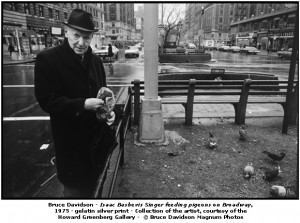
As HG remarked, this is just a smattering. There was much more. Sadly, only Zabar’s, Greengrass and Citarella’s remain. On the bright side: The West Side has added Fairway.
